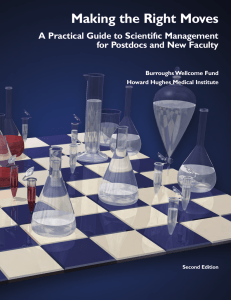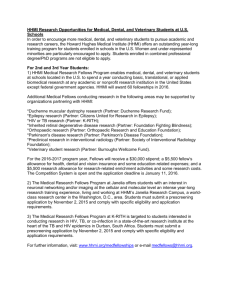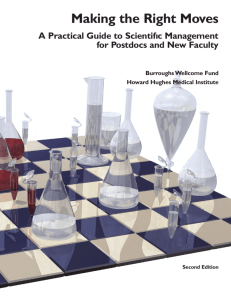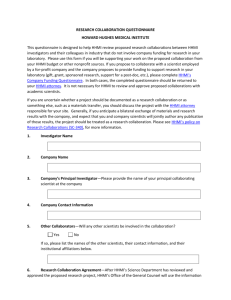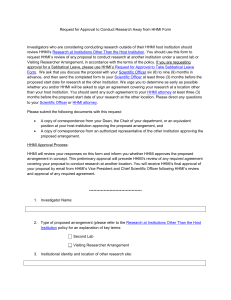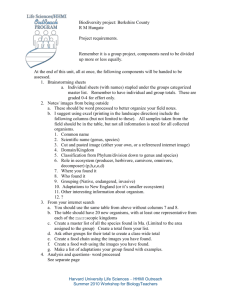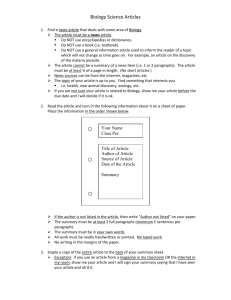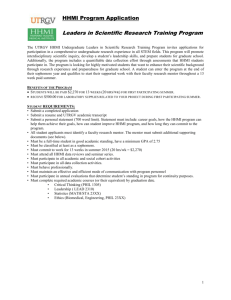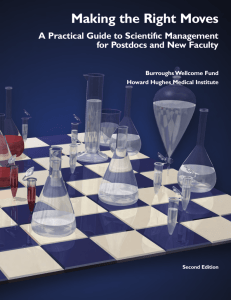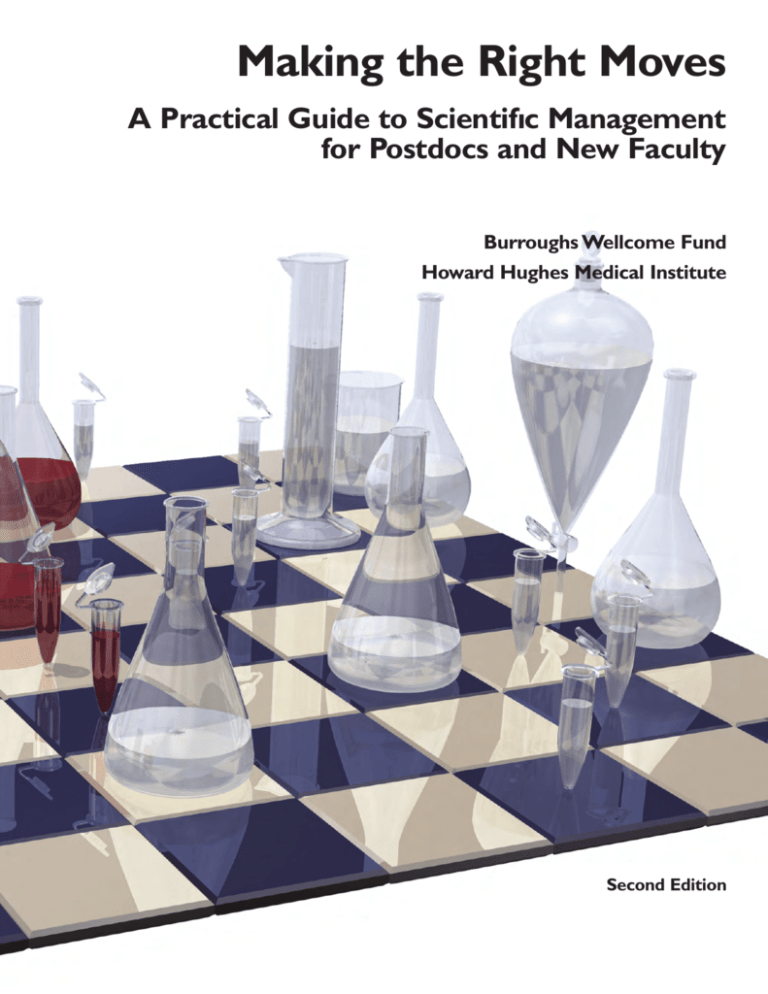
Making the Right Moves
A Practical Guide to Scientifıc Management
for Postdocs and New Faculty
Burroughs Wellcome Fund
Howard Hughes Medical Institute
Second Edition
© 2006 by the Howard Hughes Medical Institute and Burroughs Wellcome Fund
All rights reserved.
09 08 07 06 1 2 3 4 5
Permission to use, copy, and distribute this manual or excerpts from this manual is
granted provided that (1) the copyright notice above appears in all reproductions; (2)
use is for noncommercial educational purposes only; (3) the manual or excerpts are not
modified in any way; and (4) no figures or graphic images are used, copied, or distributed separate from accompanying text. Requests beyond that scope should be directed
to labmgmt@hhmi.org.
The views expressed in this publication are those of its contributors and do not necessarily reflect the views of the Howard Hughes Medical Institute or the Burroughs
Wellcome Fund.
This manual is also available online at http://www.hhmi.org/labmanagement.
Project Developers: Maryrose Franko, Ph.D., and Martin Ionescu-Pioggia, Ph.D.
Editor: Laura Bonetta, Ph.D.
Managing Editor: Patricia Davenport
Production Manager: Dean Trackman
Designer: Raw Sienna Digital
Writers: Joan Guberman, Judith Saks, Barbara Shapiro, and Marion Torchia
Copyeditors: Cay Butler and Kathleen Savory
Indexer: Mary E. Coe
Burroughs Wellcome Fund
21 T.W. Alexander Drive
P.O. Box 13901
Research Triangle Park, North Carolina
27709-3901
http://www.bwfund.org
Howard Hughes Medical Institute
4000 Jones Bridge Road
Chevy Chase, Maryland 20815-6789
http://www.hhmi.org
Chapter 3
Chapter 3
LABORATORY LEADERSHIP
IN SCIENCE
T
he day has finally come when you walk through the door of your own laboratory.
You are the boss! What got you here is your creativity and scientific expertise. But
you quickly realize that the day-to-day operation of the laboratory also requires
strong leadership and management skills.
This chapter describes the skills and competencies involved in leading and managing
a group of people. It also offers some suggestions on how to achieve them. It is
organized in four main sections. The first provides a definition of leadership in the
context of directing a scientific laboratory. The second describes the process for
developing a vision for your laboratory; your main role as a leader will be to organize
and motivate the people in your lab to enact this vision. The third is about different
leadership approaches and how you might proceed in developing your individual
style. The fourth discusses the role of the laboratory leader in building and sustaining
an effective team—that is, how to communicate with the people in your lab, how to
motivate them, how to make decisions and resolve conflicts, and how to set and
enforce expectations and rules of behavior. This chapter is largely based on material
developed by Edward O’Neil, director of the Center for the Health Professions at
the University of California–San Francisco, as well as interviews with scientists with
years of experience running laboratory research programs.
If I had one piece of advice to give it’s that although you’ve been
hired for your scientific skills and research potential, your eventual success will depend heavily on your ability to guide, lead,
and empower others to do their best work.
—Thomas Cech, HHMI
‘‘
‘‘
BWF
u
HHMI 49
Making the Right Moves A Practical Guide to Scientific Management
YOUR ROLE AS A LABORATORY LEADER
What Is Leadership?
Before getting into the details of your responsibilities as the head of a lab, or principal investigator (PI), you need to understand what leadership is. Leadership is getting a group of people to enact a vision of what needs to be accomplished. Thus,
according to O’Neil, leadership starts with a vision, and requires relationships with
others to accomplish tasks.
Leadership = Vision + Relationships + Tasks
Put into practice, this means that the leader has to perform a number of functions,
from coming up with a scientific strategy, to motivating people, to managing
budgets.
Vision. A leader has to create a vision and set the direction for the lab. (See
“Creating Your Vision as a Leader,” page 53.)
Relationships. A leader enables others in the lab to do the work in a unified manner. Thus, a leader has to
u
Build and manage teams.
u
Motivate and support graduate students, postdocs, and technicians.
u
u
u
u
u
u
Create an environment where people are able to give and receive feedback.
Delegate responsibility to others when possible.
Make fair decisions and manage conflicts.
Communicate and listen.
Be sensitive to diverse populations and needs (see chapter 5, “Mentoring
and Being Mentored”).
Be a mentor to others, as well as seeking his or her own mentors (see chapter 5, “Mentoring and Being Mentored”).
Tasks. A leader also has to manage the activities of lab members. This requires
that the PI understands the core activity that he or she is responsible for directing.
Beyond a basic knowledge of the scientific tools and processes used in the lab, the
PI must also be able to
u
u
u
50 BWF
u
HHMI
Design projects and determine time frames (see chapter 7, “Project
Management”).
Create budgets (see chapter 9, “Getting Funded”).
Write grants and papers (see chapter 9, “Getting Funded”).
Chapter 3 Laboratory Leadership in Science
u
u
Teach courses (see chapter 13, “Teaching and Course Design”).
Juggle many different demands at once (see chapter 6, “Time
Management”).
Leaders and Managers: What Is the Difference?
Although leadership and management are often used interchangeably, they do not
mean the same thing. A leader influences the opinions and attitudes of others to
accomplish a shared goal. A manager, on the other hand, is primarily an administrator, who makes sure that people and processes are in place to achieve the desired
goal. Managers need to be able to plan, budget, organize, and solve problems, to
keep a complicated system of people and technology running smoothly. As head of
a scientific laboratory, you will need to be a leader and a manager.
Developing Leadership Skills
Some of the leadership skills mentioned above, such as developing a vision statement, may come easily to you, whereas others, such as motivating people in your
lab or delegating responsibility, may prove more difficult. “Leadership development” is the process of improving your leadership skills. It involves establishing
one or several goals for becoming a better leader and making a plan for achieving
them. Here are some tips on how to go about it.
Choose a behavior that you want to modify. Say that a conflict arises between
two postdocs in the lab; their projects have converged and now they are competing
against each other over who should take charge. You realize that you should be
keeping closer tabs on the experiments being done by everyone in your lab, as well
as on the interactions among people.
Choose a specific goal for changing your behavior. You should choose a goal
that is as specific as possible and state it in clear, measurable terms. For example, a
goal that states “I will be better at communicating with people in the lab” is neither
clear nor easy to assess. You will be more likely to achieve a goal that states “I will
meet weekly with the postdoc who is working on project x to discuss in a direct
and open way progress on the project and any issues that might be affecting the
work.” This way you will be able to tell if you have or have not followed through.
Determine a timeline for completion. You need to have a realistic deadline for
assessing your progress. For example, “In one month, I will know what everyone in
the lab is working on and will have set up scheduled meetings with each person.”
Assess your progress. From the beginning you should have clearly stated the
expected outcomes of your goal, so that you will know if you have achieved them.
The questions you want to be able to answer are
u
How do I know I have been successful?
u
What difference will they notice?
u
Who are the other people who will notice and be affected?
BWF
u
HHMI 51
Making the Right Moves A Practical Guide to Scientific Management
To know if your plan is effective, you will need to create open channels of feedback. This involves asking people in your lab and your colleagues for feedback on
how you measure up against your desired model (see “Giving and Receiving
Feedback,” page 60).
How to Improve Your Leadership Skills
Improving leadership skills is often a process of trial and error, but there are some
more formal ways of going about it.
Find a mentor. To help you define and achieve a specific goal, identify someone
who does what you would like to do. For example, if one of your limitations is
making people feel valued for their work and accomplishments, you may want to
observe how another PI recognizes and rewards the people in his or her lab and
then attempt to model that behavior in your own lab. You will need to practice and
probably modify your behavior to suit your own personality and situation. Similarly,
you probably know colleagues who are good public speakers, cool under pressure,
effective at managing time, or skilled at running lab meetings. Observe these people
and identify specific positive behaviors that you see them use and then try to adopt
these behaviors. You may also ask these colleagues for feedback and advice on your
own behavior and progress. (See chapter 5, “Mentoring and Being Mentored,”
page 97.)
Read books and attend courses. You can aid your leadership development by
reading books and taking courses offered at your university, especially if it has a
school of management. Some of the scientific societies also offer seminars or short
courses in laboratory management in conjunction with their annual meetings. You
can also take advantage of the resources available through your institution’s human
resources department. A number of organizations, such as the Center for the
Health Professions at the University of California–San Francisco
(http://www.futurehealth.ucsf.edu ) or the Leadership Learning Laboratory at the
University of California–Davis (http://sdps.ucdavis.edu/browse/hr/hrs021.htm ),
can also bring tests and other resources to your institution.
Get to know your strengths and weaknesses. In most cases, you cannot change
your personal qualities, but becoming aware of them can help you lead more effectively. You will be able, for example, to make the most of your assets and work
around or improve on your liabilities. In addition, self-knowledge will make you
more aware of the personalities of people in your lab and help you direct and support them more effectively. You can take different tests to help you understand various aspects of your own personality and how you behave in certain situations; one
of the best known is the Myers-Briggs Type Indicator (MBTI). Appendix 1 (page
73) offers a brief description of the MBTI personality types and how these may
play out in a laboratory environment. More information on the MBTI can be
found at http://www.myersbriggs.org.
A popular way to understand your on-the-job strengths and weaknesses is to complete a so-called 360-degree feedback questionnaire. One example, Skillscope, published by the Center for Creative Leadership, consists of a series of questions that
52 BWF
u
HHMI
Chapter 3 Laboratory Leadership in Science
you and others answer. Your supervisor, peers, and people you supervise rate you
on what parts of your job (from communicating information and supporting the
professional development of your staff, to administrative and organizational abilities and time management skills) you excel in and what parts could use improvement. The questionnaire also gives everyone a chance to say if they think that particular skill is important to your job. It is very enlightening (and an opportunity for
discussion) to know what others consider your strengths and weaknesses compared
with your ideas about them. Responses are anonymous, except for the supervisor’s
responses. More information on Skillscope can be found at http://www.ccl.org.
CREATING YOUR VISION AS A LEADER
M ost people understand that the president of a university or the head of a large
teaching hospital must have a vision for what he or she wants to accomplish, but
how about someone running a lab? Even a six-person lab in which there is no clear
vision is likely to have postdocs and graduate students heading off in their own
directions, wasting time, and generating ill will. Developing a vision for everyone in
the lab to share does not limit innovation. Instead, it provides a foundation for creativity from which new directions may be taken.
My vision is that we are going to regenerate the heart after a
heart attack. This is really what I would like to accomplish
with my career. Initially, I was worried that I would sound
“sappy” in some fashion when I told people that I had a vision.
I found that at first people may think it’s a little odd, but pretty
soon when they hear it again and again, you start seeing people
nodding their heads and agreeing with you. Having a clearly
stated vision does help to inspire in people the mission behind
what you are working on.
—Charles Murry, University of Washington School
of Medicine
How to Create a Mission Statement
‘‘
‘‘
The cornerstone for implementing a vision for your lab is the mission statement. It
describes the kind of research you want to do, the motivation for your research,
and the kind of atmosphere in which you want to work. It should take into consideration the history and current challenges of your lab and what you want to accomplish in the short and long term, with an eye to the future work of your department and institution as a whole. As you develop your mission statement, you might
present it verbally to colleagues and your department head in an informal setting.
Following input and adjustment, the statement should be written in about one
paragraph.
BWF
u
HHMI 53
Making the Right Moves A Practical Guide to Scientific Management
As you develop your mission statement, keep in mind the following points:
u
u
u
Decide what values you want for your lab (e.g., scientific excellence, discipline, teamwork, competition).
Consider your social and financial goals, in addition to scientific ones.
Craft a statement that you feel comfortable communicating to your peers,
superiors, and lab members.
The following are two sample mission statements:
u
u
The goal of our laboratory is to be among the most successful and respected in the area
of cancer genetics. The ultimate goal is to help develop better therapies and cures for cancer. To this end, we will collaborate with other researchers in the area and share our
results and reagents. We will be recognized for being fair and collegial.
Our lab aims to understand the mechanisms by which cells transport proteins. In particular, we will focus on technical challenges that others have not been able to overcome. A
main focus of the lab is to train the next generation of scientists. We will create an environment that is conducive to learning and testing new skills.
Keep in mind that mission statements are not operating plans or strategic maps for
the lab, but they serve to shape these essential elements. In addition, they are not
static; they evolve and change with time.
Once you have a mission statement that you are comfortable with, start saying it
over and over to the people in your lab. Mention it at lab meetings, when people
first join the lab, when you sit down to write a paper. Every decision you make
from now on—from hiring staff to choosing scientific projects for the people in
the lab to establishing how communication
flows—should be made with this statement
in mind.
Developing Your Mission
Statement
u
u
u
u
u
Paint with broad strokes, but also identify key
measures of success.
Provide both reasoned and emotional justification for the vision.
Tie it to the values and culture of your department and school.
Be clear and honest.
Create a distinct future that distinguishes your
research program from others, especially those
of competitors.
54 BWF
u
HHMI
Chapter 3 Laboratory Leadership in Science
DEVELOPING YOUR LEADERSHIP STYLE
Your mission statement is what sets the course for your lab, but how do you go
about directing and motivating people to accomplish this vision? The way in which
you carry out your role as a leader is called your “leadership style.” It will depend
largely on your own personality and the types of mentors you have had up to now.
For example, you may find you feel more comfortable making decisions on your
own, without seeking the input of others in the lab or colleagues. Or you may find
it difficult to give unsolicited feedback to your students and postdocs. After a few
months of leading your own lab, you will most likely develop a style that you feel
comfortable with. But management experts tell us that different styles are required
for different situations and different individuals, and that you should practice using
a variety of such styles.
Four Styles of Leadership
Figure 3.1.
Blanchard
and Hershey
model of
leadership
styles
Supportive Behavior
Ken Blanchard, best known for the “One Minute Manager” series, and Paul
Hershey proposed one classic research model for so-called situational leadership.
They visualized leadership styles in terms of a continuing spectrum of directive
and supportive behavior. Directive behavior involves clearly telling people what to
do, how to do it, and when to do it, and then closely monitoring the behavior.
Supportive behavior involves listening to people, providing assistance and encouragement, and then facilitating their involvement in problem solving and decision
making. According to this model (see figure 3.1), the degree to which you direct
and support people who work for you is influenced by their level of competence
and their commitment to completing a given task.
High
Supporting
Coaching
Delegating
Directing
Low
Low
High
Directive Behavior
Source: Adapted from a concept developed by the Center for Leadership Studies, Inc.
BWF
u
HHMI 55
Making the Right Moves A Practical Guide to Scientific Management
The four styles of situational leadership are described below.
Directing. This style puts a high focus on task and a lower one on relationship.
When the person you are supervising is not yet qualified or not sufficiently motivated to carry out a task independently, then you need to tell him or her precisely
what to do at each step. For example, you may take this approach with a technician
who has just started working in the lab and needs to learn an important technique
that he or she will be doing routinely.
Coaching. This style puts a high focus on both task and relationship. As a PI, you
would continue to direct the action of the person you are supervising, but also take
the time to explain decisions, solicit suggestions, and support the individual’s professional development. This leadership style is the most demanding. It requires a lot
of time and emotional investment on the part of the leader. For example, soon
after a graduate student joins the lab, you will probably have to show him or her
different techniques and help him or her decide which experiments to do, but you
would explain why and how they fit in with the lab’s mission.
Supporting. This style puts a low focus on task and a higher one on relationship.
As a PI, you would facilitate people’s efforts toward accomplishing a given task and
share responsibility for decision making with them. In a lab, the PI is likely to adopt
this leadership style with most postdocs and experienced graduate students. For
example, you would give the postdoc responsibility to choose what experiments to
do but continue to discuss what these are and facilitate progress by, for example,
helping the postdoc find someone to collaborate with so that he or she can get the
next step of a project accomplished.
Delegating. This style puts a low focus on both task and relationship. As a PI, you
would turn over responsibility for decision making and problem solving to an individual who has become more independent. For example, you would allow a postdoc who is ready to leave the lab to make decisions about what projects to pursue
and collaborators to seek out without having to ask for your input first.
Delegating Tasks and Authority
Many PIs, especially starting PIs, are reluctant to delegate for fear of losing control
or power. Delegating is important because it will relieve you of some of the day-today responsibilities. Assigning responsibility does not lessen your role in the lab. It
merely gives you a capacity to handle greater responsibility. In addition, delegating
serves to empower and motivate the people who work for you.
In deciding whether there is something you could delegate, ask yourself the following questions: What am I doing now that I’d like to see someone else do? Is there a
person in the lab who is capable of handling and willing to take on a new responsibility? What could I do if I had more free time?
Once you have decided to delegate the responsibility for a given task, you need to
u
u
56 BWF
u
HHMI
Be sure you delegate the necessary authority with the responsibility.
Give clear directions and make sure they are understood; keep two-way
communication channels open.
Chapter 3 Laboratory Leadership in Science
u
‘‘
u
u
Clearly define the responsibilities assigned to each lab member, and make
this information known to everyone in the lab.
Once you have delegated, follow up to make sure the job is being done
without interfering with it.
When you delegate authority to someone, be sure to back up that person
when his or her authority is called into question.
Distribute responsibilities fairly among members of the lab.
Through the years I’ve learned that, on the one hand, there are
a bunch of ways to treat people that generally work well; on the
other hand, each individual case seems to bring up something
new that you don’t have experience with. So even though you
think you’ve developed all of this experience, with the very next
circumstance, you may have to fine-tune your approach, because
every person is different.
—Thomas Cech, HHMI
BUILDING AND SUSTAINING
AN EFFECTIVE TEAM
‘‘
u
Today, more than any other time in history, science is a team sport—and the
teams keep getting bigger. For many kinds of experiments, you need to integrate
different kinds of technical expertise and backgrounds. Regardless of the size of
your lab, there are some general guidelines for keeping the team members motivated and working effectively, from communicating and giving feedback to setting
specific rules of behavior. They are discussed in the sections below. (For more
information about how to collaborate with other labs, see chapter 12, “Setting Up
Collaborations.” For more information about how to select lab members, see chapter 4, “Staffing Your Laboratory.”)
Communicating Within the Lab
You should communicate with laboratory members on a daily basis. If you are still
doing experiments at the bench, you will be accessible to your lab members. But, if
you spend most of your time in your office writing papers and grants, make an
effort to walk around the lab at least once a day, if possible, and informally chat
with people. Unless you need to concentrate on a task without interruptions, keep
the door to your office open.
In addition to these informal interactions, formal meetings are an organized way to
ensure that everyone is kept informed of the group’s activities and results and for
BWF
u
HHMI 57
Making the Right Moves A Practical Guide to Scientific Management
you to reiterate your expectations and values. By all means, hold regular goal-setting
and evaluation sessions: an annual lab retreat, periodic lab meetings involving the
full staff, weekly or more frequent small-group meetings to discuss specific issues,
and regularly scheduled one-on-one advisory meetings and performance evaluations. Group activities, held periodically, are also important for building morale and
encouraging lab members to think of themselves as part of a team.
Research group meetings. Many research groups hold weekly meetings. One or
more people in the lab take turns presenting what they’ve done since they gave
their last presentations. They give an introduction, share their results and their
interpretation, and then discuss what they plan to do next. Comments and suggestions from the research team usually follow. In some labs, especially larger ones, a
research group meeting is a semiformal presentation with overheads or PowerPoint
slides and can be a somewhat intimidating experience, especially for a graduate student. In smaller labs, these meetings may be more informal—for example, each
person discusses what he or she did that week. These meetings are much more
interactive. Yet, even in smaller labs, it’s important to schedule occasional formal
presentations so that students and postdocs can perfect their ability to speak about
their research. Another good idea is to have joint research meetings with other labs.
It is good experience for your lab members to give presentations to scientists outside your lab. It can help to clarify presentations and garner new ideas from those
who aren’t so closely involved with the project. It also extends your network and
that of your students, which is especially useful when they are looking for jobs or
letters of reference.
One-on-one meetings. Regardless of the frequency of research group meetings,
you should meet often with each lab member to keep current with progress and
problems. Invite your students, postdocs, and technicians to come into your
office with their lab notebooks and
Guidelines for Effective
show you what they’ve been working
Meetings
on. Many PIs meet with lab members
For most formal types of meetings you should have
for an hour each week. They may meet
a predetermined plan for the meeting that states its
with them more frequently immediately
goals and purpose:
after lab members have finished a series
of experiments or when they notice that
u Solicit agenda items and distribute an agenda
a lab member is struggling.
before the meeting.
u
u
u
u
58 BWF
u
Have clear assigned roles for the meeting—
that is, who will speak, who will take notes,
who will lead the discussion.
For each action item on the agenda, go over
discussion points, make a decision, and determine postmeeting actions.
Discuss what should be on the next meeting
agenda.
Follow up the meeting with a meeting summary and a to-do list.
HHMI
Performance reviews. The performance review meeting with lab members
is an opportunity for you to clarify your
expectations, review their recent accomplishments, and set performance goals.
It is also a good time to talk about their
career goals and how their work in your
lab contributes to achieving those goals.
Another important purpose of performance evaluations is to provide lab
members an opportunity to give you
feedback on your leadership style. Work
Chapter 3 Laboratory Leadership in Science
with your institution’s human resources department to make sure you conform to
your institution’s performance management process. Appendix 2 shows a sample
performance review form, created by Tamara Doering. She gives the form to lab
members a few days before the meeting. The form consists of two parts: a selfassessment section that is completed by the lab member before the meeting and a
joint feedback section that is completed during the meeting. In addition to a
focused discussion of short- and long-term goals, the twice-yearly meeting gives lab
members an opportunity to give feedback on Doering’s leadership style. The form
offers some suggestions about what to evaluate and how to engage lab members in
self-evaluation. Appendix 3 includes a checklist developed by HHMI’s Department
of Human Resources; it can also help you prepare for a performance feedback session with a lab member.
Small-group meetings. Some labs also have meetings attended by individuals
working on specific projects or with specific techniques. This is where lab members
deal with logistics and technical matters, and they hammer out experiments, trying
to get different approaches to work.
Strategy sessions. Should you decide that your research needs to take a new direction, you may want to call an official strategy session. A strategy session helps the
group identify the next most important questions and what experiments will answer
these questions. Such a meeting also helps the group develop a shared understanding of the lab’s direction and clarifies what needs to be done and who is interested
in what aspects of the new research area. In addition, these meetings help you
determine how potential conflicts and competing interests can be avoided.
If a PI has 20 people in the lab and you ask the PI at any
moment, “What is person number 17 doing?” he or she should
be able to give you a two-hour talk on this without any preparation. The sine qua non for being a good lab director is having
all of this in your head.
—Thomas Cech, HHMI
In my lab, there are five or six breakout groups that meet once
a week or two, and that works really well. It gives them a teambuilding experience.
—B. Brett Finlay, University of British Columbia
‘‘
‘‘
BWF
u
HHMI 59
Making the Right Moves A Practical Guide to Scientific Management
Journal club meetings. These meetings are an integral part of training new scientists and can vary in frequency from weekly to monthly, or as desired. The discussion of a scientific report serves to illustrate how to and how not to construct and
test a hypothesis, what constitutes effective analysis, and how to report scientific
findings. In addition, a journal club meeting reinforces the idea that reading current
papers is essential to keeping up with the field. These meetings also provide an
opportunity to communicate your values about science when discussing other
people’s work.
[At journal club meetings] we discuss papers and talk about
their weaknesses, and it makes it clear that we don’t want our
papers to have those kinds of weaknesses. I think the scientific
rigor issues come up as we go along.
—Tamara Doering, Washington University School
of Medicine
‘‘
‘‘
Informal group activities. Organizing social occasions to celebrate a major
accomplishment—publication of a paper, a job, a grant—is important for promoting your shared vision of the lab and building morale. In addition, most PIs agree
that it is important that lab members occasionally socialize in a relaxed, nonwork
environment. Such get-togethers can help promote team building and enhance
communication among lab members. As you are establishing your lab, you might
have to arrange these outings. After a while, they will occur more spontaneously.
Don’t feel that you always have to participate, and don’t feel offended if you are
not invited to all after-hours occasions.
Giving and Receiving Feedback
Giving and receiving feedback is a critical leadership skill. Receiving feedback from
individuals in your lab will help you improve as a leader and help you steer people
toward your vision. In turn, giving them feedback will help them develop as scientists and ensure that your expectations are met. Feedback should be given informally, on a daily basis, as well as during formal meetings. Giving feedback and communicating with your group on a regular basis help instill the culture of “feedback,”
and can also make it easier to approach lab members about specific situations or
problems, since they are used to regular sessions with you. It also helps avoid
unpleasant surprises from members of your lab.
Giving Feedback. When you give feedback to people in the lab, try to
u
60 BWF
u
HHMI
Time it well. Feedback during stressful times (e.g., when a grant deadline is
looming) is rarely helpful, especially when either party is angry, or when
someone is not ready to receive feedback.
Chapter 3 Laboratory Leadership in Science
u
u
u
u
‘‘
u
Be specific and objective. Focus your comments on first-hand data, actions,
and behavior and not on the person or speculation about his or her intentions. For example, instead of saying “You are not focused enough on your
work” or “You don’t seem to care about your experiments,” think of a specific instance that you thought was a problem. “We decided at our meeting
that you would do these three experiments, but you only did one.”
Reinforce expectations. Provide feedback in terms of previously outlined
goals and decisions (e.g., “We decided at the last meeting...”).
Avoid subjective statements. An example of such a statement is “I don’t
like the fact that you show up in the lab whenever you feel like it.” Try
instead to stick to objective arguments: “If you arrive at unpredictable
times, it is difficult for other people in the lab to know when they can talk
to you. Many people depend on your expertise and need to know when you
are available.”
Present it in a constructive way. Feedback should be seen as a method of
improving rather than as a punitive step. To this end, ensure that the student or postdoc has a plan for dealing with any problems you have identified and arrange a way to monitor progress. Why does the postdoc come to
the lab late in the day and have an erratic work schedule? Does she need to
adjust her daily routine and go to sleep earlier? Does she have a problem
with getting transportation to and from the lab? Suggest ways to overcome
these problems and agree on a deadline for reevaluating the problem:
“From now on I expect you to be in the lab at 10 a.m. and to attend all
scheduled lab meetings. Talk to Dave or Jane about carpooling to the lab.
We can talk again in a week to see how you are doing.”
Make sure it registers. Feedback is often subject to distortion or misinterpretation. You may want to ask the student or postdoc to rephrase what
you have said and talk about his or her assessment of the issues you raised.
Avoid giving too much. Select the highest-priority issues to start with, and
remember that time and space are needed for integrating feedback.
Although I know it’s important, it is hard for me to let people
know when their behavior does not meet my expectations. When
I first opened the lab, I was more uncomfortable with this than I
am now. Basically, I’m quicker to call people on it now. If
things are not working and the quality of their work is somehow slipping, or the effort that they are putting in is somewhat
dropping, I have an easier time saying, “This isn’t right, you
have to change it now.”
—Charles Murry, University of Washington School
of Medicine
‘‘
u
BWF
u
HHMI 61
Making the Right Moves A Practical Guide to Scientific Management
Receiving feedback. Invite people in your lab to provide feedback on specific
issues by asking questions during lab meetings or scheduled one-on-one meetings.
Make it a point to meet with your department chair on a regular basis and have
lunch with senior colleagues to get a sense of how they think your work is progressing and whether you are on track for getting tenure. (If they have not been
paying attention to your work, this conversation will motivate them to start doing
so). But remember, to get honest comments and suggestions, you must be receptive. If you respond angrily or defensively, those in your lab and other colleagues
will be reluctant to give you their opinion. As you are listening to a comment, try to
understand what the other person is saying. If something is not clear, ask for clarification. If the feedback is negative, take time to think about what you heard, even
if you don’t agree. What behaviors might have caused these perceptions? What
changes, if any, do you need to make?
Making Decisions
As a PI you will be making tens if not hundreds of decisions a day, from determining which e-mails to open and what type of answer to give each one, to choosing
to hire a new postdoc. In each case, the first step in making a decision involves
understanding the demands of the situation by answering the following questions:
u
u
u
u
u
u
u
How important is the decision I have to make? For example, hiring a new
technician is a serious commitment. You will have to interview the candidate and carefully research his or her background before you make a decision. On the other hand, whether or not you agree to referee a paper is
unlikely to carry very serious consequences.
When do I need to make the decision?
Do I have enough information to make the decision?
How critical are the consequences of this decision?
Who needs to know or cares about the decision I am about to make?
Will I need assistance or approval from others?
If I have made that kind of decision before, can I use the same approach?
Answers to these questions will help you choose the most appropriate decision
style—that is, the degree to which you go at it alone or include others.
Making a decision in complete isolation. This decision style works best when
you are under severe time constraints, there is no need for buy-in from other people, you alone have the best insight, or you are dealing with highly confidential
information. For example, if another scientist approaches you to collaborate on
some experiments for a paper that he is in a rush to publish, you may quickly
decide whether it is worthwhile for you to get involved. You can make this decision
without consulting anyone else if the work can be done by yourself or a technician.
Another example would be to decide whether to referee a paper or write a reference letter for a postdoc.
62 BWF
u
HHMI
Chapter 3 Laboratory Leadership in Science
Making a decision after consulting with other individuals, but without necessarily telling them why. You would use this decision style when you need input
from others and have sufficient time to gather information. In general, this
approach improves the quality of the decision, but you run the risk of involving
people who are not really participating in the decision-making process, which may
lead to resentment or misunderstanding. For example, if approached by another
researcher to collaborate on a project, you may ask your colleagues whether they
know this person and what his or her reputation is. A PI considering taking on a
new research direction may consult with the department head and postdocs and
students in the lab. But the decision ultimately rests on the shoulders of the PI.
Steps in
Making a decision with the group. This decision style is helpful when you have
few time constraints, need the buy-in or technical experience of the group, or need
a creative response. It is more time-consuming than the two discussed above, but in
some cases it improves the quality of the decision. For example, when deciding
whether or not to invite a new postdoc to join the lab many PIs will decide jointly
with existing lab members. Another example is when a PI has to decide whether or
not to buy a new piece of equipment that he
or she has little experience with. There may
be postdocs in the lab who are more knowlMaking a Decision
edgeable and can make a better decision.
1. Determine the type of decision that you need
to make.
2. Pick a style that is appropriate for the decision
and situation. (Remember, different decision
styles will fit different situations and you should
be equally comfortable using any of the styles
when appropriate.)
3. Make the decision.
4. Keep a log of all your decisions, giving a brief
description of the issue at hand, the decision
type, and what the decision and outcome were.
5. Go back to the log once a month to see how
each decision is playing out.
Passing the decision on to others. It may
be appropriate to let other people in your lab
make a decision in cases where the decision is
more important to them, you have little competence in the particular issue, or you have
other more pressing priorities to deal with.
The most important thing to consider in this
case is that you will have to live with the decision, whether you like it or not. The last thing
you want to do is overturn a decision once it
has been made. For example, you might let a
senior postdoc decide on his or her own
whether to collaborate with another scientist
or where to submit a paper.
Depending on your personality, you probably prefer to make decisions in one particular way. For example, if you are an introvert, you may gravitate toward making
decisions on your own, without too much group discussion. But people in your lab
will appreciate being involved in some of the decisions. It is a good idea to try to
experiment with different decision styles in different situations.
Setting and Communicating Rules of Behavior for
Members of Your Laboratory
A key aspect of your role as a lab leader is to set and effectively convey expectations that reflect your vision for the lab. Some expectations may apply to a particular group of lab members (e.g., postdocs), and others will be unique to each individual. You may want to work with your lab members to set these expectations—
BWF
u
HHMI 63
Making the Right Moves A Practical Guide to Scientific Management
this can increase the likelihood of buy-in and help increase motivation. The best
way to communicate expectations is to convey them continually—at the first interview, on the first day on the job, at lunch time, during lab meetings, and, most
importantly, by setting an example. It’s also a good idea to communicate your
expectations in writing, especially for new lab members and when conducting staff
reviews, and to periodically review them with your staff. As a general rule, you
should live by the expectations you set for your lab members. Show your workers
that you enjoy what you are doing. Especially in the early years, be present in the
lab, working side by side with them. They will be able to see how you work and
what is important to you.
‘‘
I give a “state of the lab” talk once a year. I start with reviewing the accomplishments, the things that have gone well over the
last year. I try to point out things that everyone has done so that
there is a sense that everyone has been recognized for their part.
Then I go over the lab budget—what our “burn rate” is, where
our money is coming from—and talk a little bit about money
management issues and strategies.
—Charles Murry, University of Washington School
of Medicine
—B. Brett Finlay, University of British Columbia
‘‘
We have a package that we give people on arrival that tells
them what their lab duties are and how the lab is run. The
faster you can get new lab members to the bench and get them
going, the better it will be.
Below are some general areas that you will want to consider when setting expectations for people in your lab.
Question: How do I avoid potential misunderstandings among lab members regarding work hours
and time off?
Answer: The best way to handle this is to convey
your expectations about work hours and time off to
applicants during the interview. For example, the
amount of vacation leave varies from country to
country (e.g., it is usually longer in Europe than in
the United States), so you should let applicants
know about your institution’s and your lab’s policies.
64 BWF
u
HHMI
Work hours. Some PIs feel they should stipulate a specific number of hours per week
that they expect graduate students or postdocs to work. But that strategy does not necessarily work well and can generate resentment. Focusing on productivity will prove
more successful than focusing on the number
of hours or on the specific hours an individual works. Nevertheless, you will probably
want the members of your laboratory to be
present during certain hours—to make sure
that they can interact with you and the other
lab members. Generally, your own work
Chapter 3 Laboratory Leadership in Science
hours set the pace for your group. If you leave the lab at 6:00 p.m., don’t expect
people in your lab to be working late into the evening.
Prolonged absences. Communicate your expectation that lab members should
give you several weeks’ notice about an upcoming vacation. Inform them of the
vacation and personal leave limits at your institution. Your institution will also have
guidelines about maternity and paternity leave. It is best to follow these guidelines
rigorously.
Some labs get a bad reputation when PIs say, “We expect you
to be here every Saturday and never take vacations,” or something similar. I think what you want to do is set an example
and help your people find how to be most effective. It is possible to work regular hours, but one has to be very organized
about it. I have had very efficient people who can be very productive working nine to five and just use their time well. I
have also had other people who don’t use their time well, and
so I try to work with each lab member to help them figure out
what works best.
—Suzanne Pfeffer, Stanford University School of
Medicine
‘‘
‘‘
Authorship of papers. The inclusion and order of authors on a paper are often
sources of discord in the lab. In deciding who should be an author on a paper, the
PI has to consider who has contributed to particular aspects of the work. All lab
members who are involved in a project should express their expectations concerning authorship and credits on the resulting paper, and provide their rationale for
being considered as an author.
Here are some guidelines to consider:
u
u
u
u
The first author is normally the individual who is primarily responsible for
the project.
Occasionally, two individuals may share that responsibility; most journals
permit a statement that indicates that the first two or three authors listed
have each contributed equally to the publication.
It is unwise to make upfront promises about authorship. You may choose
to make it a policy in your lab to wait until you know how much each person has actually contributed before authorship is assigned.
In deciding whether to include someone as an author, ask “Could this project
have been done without this person’s conceptual or technical contribution?”
BWF
u
HHMI 65
‘‘
Making the Right Moves A Practical Guide to Scientific Management
—Suzanne Pfeffer, Stanford University School of
Medicine
‘‘
I have included a student on a paper because he had a conceptual
contribution without which the whole study could not have been
done. There was no question, everybody wanted this person on
the paper—so an author doesn’t have to contribute an actual
figure if they’ve contributed something that was essential for that
project to go forward.
Scientific ethics. The best way to communicate responsible conduct in research to
your lab is to live by those values. As a leader, you should talk about important ethical issues (e.g., scientific rigor and reproducible and discrepant results) in a lab
meeting or in a more informal setting. Most universities offer lectures or seminars
in scientific ethics, and you should encourage your staff to attend. An introduction
to the ethical conduct of research is a report from the Institute of Medicine,
Integrity in Scientific Research: Creating an Environment That Promotes Responsible Conduct,
which is available from National Academies Press at http://www.nap.edu. You
should also make it possible for your research staff to discuss and report concerns
to you in a confidential manner.
Project ownership. The PI, with input from individual members, usually decides
what projects people in the lab work on. Some labs have strategy discussions every
three to four months during which everyone talks about what projects they would
like to continue or initiate. Work in the lab is most effective and productive when
members have clearly defined projects that are sufficiently distinct so that each person can carry out some independent work, and at the same time the projects are
interrelated so that no one is working in a vacuum. This way, everyone in the lab
can consult with and motivate each other.
‘‘
Policy on letting projects leave the lab. You should develop a clear policy concerning whether or not you will allow postdocs to take their projects with them
—Tamara Doering, Washington University School
of Medicine
66 BWF
u
HHMI
‘‘
I often encourage people to collaborate or help each other with
techniques. So if someone has an idea, I’ll say, “Why don’t you
go to so and so? She has been thinking about that or knows
how to use that machine. Why don’t you talk to her?” And I
try to make it reciprocal as much as I can.
Chapter 3 Laboratory Leadership in Science
when they leave your lab. Communicate this policy to all prospective postdocs.
Some PIs let their postdocs take whatever they had worked on during their stay in
their labs, with no strings attached. Others will let postdocs take some aspects of
their projects to serve as the focus for their new labs. In these cases, the PI makes
sure that he or she does not compete directly with the former postdoc’s project for
a few years, until the postdoc’s lab is well established. When you develop your policy, think about how you would want to handle a situation in which the research
results are different from what you anticipated or a situation in which the results
lead to interesting new avenues of research. If you have a small research group and
a focused area of research, you may not be able to let departing postdocs take their
projects with them. In this case, you might have to develop some alternatives to
benefit them. One possibility is to give your postdocs six months of salary and
resources to generate preliminary data for a new research question or direction. If
this is not possible, you may encourage your postdocs to work on two projects: one
that contributes directly to the mission of the lab and one that is related to what
the lab does but is not a main focus. The postdocs are free to take the latter projects with them.
I personally think it’s unfair to say to someone who has slaved
away in your lab for three years and goes looking for a job,
“You can’t continue what you’ve been working on,” because then
that person won’t be able to get a grant.
—B. Brett Finlay, University of British Columbia
The head of a lab needs to be generous, and that is hard for
junior PIs because you feel like you are just starting and everything is crucial to the success of your research program. So it’s
hard to let postdocs take projects with them. But they need to,
and the main thing is to communicate about it.
—Tamara Doering, Washington University School
of Medicine
Keeping Lab Members Motivated
‘‘
‘‘
One of your key roles is to motivate people to work hard toward achieving your
shared vision. While different people respond to different types of internal and
external motivation, most people are motivated when their contributions to the laboratory are recognized and appreciated. According to Edward O’Neil, to feel motivated, most people require the following:
u
Choice: People want to make some decisions. As a PI, make sure you give
people appropriate responsibilities, involve them in discussions about general scientific strategy, and listen to their ideas.
BWF
u
HHMI 67
Making the Right Moves A Practical Guide to Scientific Management
u
u
u
u
u
u
Competence: People need the skills to do the work that is expected of them.
As a PI, check competences by asking someone to do an experiment with
you or ask appropriate questions.
Purpose: People need to understand the importance of their role in the lab
and in scientific enterprise. As a PI, it is important for you to set goals that
define success for each person in the lab and make sure they match with
what the person is doing. It is important to listen to what each person
wants to do and understand what his or her goals are. If a postdoc has
decided to pursue a career in industry, trying to motivate him or her to follow in your footsteps into academia will not work. As a lab leader, you
need to address your lab members’ individual goals while you work
together to realize your shared vision.
Recognition: You need to provide continuous feedback to your lab members.
Comments and suggestions should be provided in the context of the given
expectations. Special accomplishments, such as publishing a paper or getting a difficult technique to work, require special recognition, such as a lab
outing.
Feeling comfortable: To be able to focus on their work, people have to feel
comfortable in their environment. One example is that some lab members
like to play music in the lab, while others get distracted by it. The working
environment needs to be comfortable so that your lab members look forward to coming to work everyday and enjoy conducting research in your
lab with their colleagues.
Progress: Satisfaction in achieving goals should not be in the distant future.
It is a good idea to schedule individual meetings as often as once a week to
set deadlines, solve problems, and plan future experiments.
Enthusiasm: You undoubtedly love science for the thrill of discovery, of
finding the answer to an important scientific question that has never been
answered before—share your enthusiasm and soon others in the lab will
follow your lead.
Barring personal problems, when these factors are in place people should feel motivated to work in your lab. A lack of motivation may manifest itself as a decrease in
productivity; someone who was productive will stop producing results consistently
week after week. You will first need to determine the cause for this decrease. Is it
an interpersonal problem in the lab, an experimental obstacle, or a personal crisis?
Discuss the problem with the lab member and see whether you can jointly develop
a strategy to address the issue or minimize the impact of the lab member’s actions.
68 BWF
u
HHMI
‘‘
Chapter 3 Laboratory Leadership in Science
I think the mistake a lot of us make is to assume all too often
that individuals don’t have any contribution to make, just simply because it might be a minor contribution. I think gaining an
appreciation of what everyone brings to the table is extremely
important.
—Gail Cassell, Eli Lilly and Company
When people present a really good result at a lab meeting, I’ll
say, “That seems like a pizza result,” and I’ll buy pizza for the
lab in their honor. Sometimes it’s by way of appreciation rather
than an important result. If someone—say a junior technician—gets stuck in a cloning project for a long time and then
gets the construct he’s been trying to make, that’s a pizza result.
—Tamara Doering, Washington University School
of Medicine
—B. Brett Finlay, University of British Columbia
Managing Conflict in the Lab
‘‘
I do half-hour meetings with each person once a week. If they
come in and say, “Nothing worked,” I say, “OK,” and change
the subject because I realize that probably 90 percent of the
experiments as a scientist don’t work. I’ve found that this
approach is a very subtle but effective motivator. Most people
don’t want to come into my office week after week and say,
“Nothing worked.”
Conflict is any situation where one person’s concerns or desires differ from those
of another person. In the lab, conflicts often arise over “turf wars,” when two individuals are interested in the same project. By staying on top of what each member
of your lab is doing, you can often spot potential problems and deal with them
before they become too serious.
Most people tend to avoid conflict. But we should think of conflict as a creative
part of our lives. Conflict has the potential of both positive and negative effects.
Depending on how it is managed, conflict can be constructive or destructive, be
stimulating or unnerving, produce higher-quality results or stifle a project, lead to
original thinking or cause destructive power struggles.
Kenneth W. Thomas and Ralph H. Kilmann provide a useful model for evaluating
an individual’s behavior in conflict situations. The Thomas-Kilmann Conflict
Model describes a person’s behavior in a conflict situation along two basic
BWF
u
HHMI 69
Making the Right Moves A Practical Guide to Scientific Management
dimensions: assertiveness—that is, the extent to which an individual attempts to
satisfy his or her own concerns—and cooperativeness—that is, the extent to which
an individual attempts to satisfy the concerns of the other person.
These two basic dimensions of behavior can be used to define five specific modes
of dealing with conflict that everyone is capable of using.
Competing. This conflict-handling mode is assertive and uncooperative.
Competers pursue their own concerns at the other person’s expense. They use
whatever powers seem appropriate to win their position, including their ability to
argue or their rank. This conflict mode works when you are dealing with a vital
issue, an unpopular decision, or a decision that needs quick action. However,
although it sometimes seems justified, the mistake many scientists make is to stay in
individualistic, competitive mode all the time. For example, if the head of another
lab asks you for a reagent that you have not yet cited in a publication and that one
of your postdocs is using for his or her project, you may refuse to share the
reagent until your postdoc has published a paper referring to it. The decision will
probably make you unpopular with the other PI, but you are safeguarding the interests of your postdoc.
Accommodating. This mode is unassertive and cooperative—in other words, the
opposite of competing. Accommodators often neglect their own concerns in order
to satisfy the concerns of others. Times when the accommodating mode is appropriate are when you want to build political capital or create good will, and for issues
of low importance. However, keep in mind that the accommodating mode can be a
problem if you keep a tally and expect that the other person will be accommodating next time. For example, you and your collaborator are sharing a piece of equipment that just broke down. He insists that you pay for the repairs since your lab
uses it more. You don’t agree, but you give in on this one because you know that
his lab uses all the other shared equipment more so it will be his turn next time a
piece of equipment needs repair.
Avoiding. Avoiders are unassertive and uncooperative. They do not immediately
pursue their own concerns or those of others. The conflict is never addressed by
avoiders. Many times people will avoid conflicts out of fear of engaging in a conflict or because they don’t have confidence in their conflict management skills. But,
avoiding can be a good strategy in cases where the person you are in conflict with
has much more power than you do or when issues are not that important. It is also
a good strategy when you need to buy time. An example of how to do this is to say
“These are serious changes. I will need some time to think about it.”
Collaborating. This conflict-handling mode is both assertive and cooperative—the
opposite of avoiding. Collaborators attempt to work with the other person to find
some solution that fully satisfies the concerns of both persons. They dig into an
issue to identify the underlying concerns of the two conflicting individuals and try
to find an alternative that meets both sets of concerns. With such a positive outcome, some people will profess that the collaboration mode is always the best conflict mode to use. However, collaboration takes a great deal of time and energy;
thus, it should be used only when the conflict warrants time and energy. For example, if two postdocs are arguing over “territory,” you might want to spend the
70 BWF
u
HHMI
Chapter 3 Laboratory Leadership in Science
necessary time to carefully carve out different projects in a way that will satisfy
both postdocs. On the other hand, if your postdocs are in conflict about which day
to hold a lab meeting, the time and energy necessary to collaboratively resolve the
conflict is probably not beneficial.
Compromising. On the negotiating continuum, this mode lies somewhere
between assertiveness and cooperativeness. The goal of the compromiser is to
find an expedient, mutually acceptable solution that partially satisfies both parties.
The compromiser gives up more than the competer, but less than the accommodator. He or she addresses an issue more directly than the avoider, but does
not explore it in as much depth or detail as the collaborator. This mode of conflict resolution is useful for decisions of moderate importance, when you have
equal power status, or when you are faced with an issue that needs to be resolved
quickly. In general, academics tend to underutilize this mode of handling conflict.
For example, say your department chair goes back on her agreement to give you a
semester free of teaching responsibilities. She tells you that she is desperate and
needs you to teach Introduction to Biology for 200 students, including labs during
your first semester. You point out that it is stipulated in your contract that your
first semester would be free of teaching responsibilities; however, you are willing
to teach a smaller, graduate-level course. You of course would rather not teach
anything and are not contractually bound to teach your first semester, but you also
know that it is in your best interest to accommodate your chair’s wishes as much
as possible.
Each of the conflict-handling modes has
value; none is intended to be good, bad, or
preferable in all situations. A worthwhile goal
Steps for Dealing with Conflict
for you as a PI is to increase your repertoire
When faced with conflict:
of responses to conflict, with the flexibility
to use various modes in different situations
u Assess the problem.
and in appropriate ways.
u
u
u
Assess the other person’s interests.
Acknowledge the constraints.
Select a strategy that balances the importance
of the problem, time constraints, power differences, and the relationships of the people
involved.
The people who work for you in your lab will
also tend to adopt one style of handling a
conflict over another. You will have a mix of
competers, accommodators, and avoiders.
Show them by example that there are different ways of handling conflict depending on
the situation.
Resolving a conflict between lab members. When conflict occurs between two
or more members of the lab, determine whether it is necessary for you to step in
and facilitate a resolution. Usually, most people will be able to resolve their own
conflicts, but make sure that a conflict does not fester to the point where it affects
morale and the atmosphere in the lab.
Here are a few tips for how to help resolve conflict in the lab:
u
Foster an environment that accepts conflict, as long as the difficulties are faced
openly and honestly by the people involved. The PI can actively reinforce
openness by lab members, especially the participants in a conflict episode.
BWF
u
HHMI 71
Making the Right Moves A Practical Guide to Scientific Management
u
u
Help the individuals involved in a conflict synchronize the timing, focus,
and extent of their overtures and responses. The PI may, for example,
invite the people involved in a conflict to the office at a designated time to
discuss the problems openly and honestly, and come to a resolution.
Make sure that each person understands the other’s point of view. The PI
can do this by summarizing, clarifying, focusing questions, and encouraging
listening by each person.
Resolving conflicts between you and others in the lab. Conflicts between the
PI and the lab members also occur. Such conflicts are important and influential in
developing the future course of the lab, particularly during the early stages. It is
important that the leader demonstrates interest in receiving and understanding negative feedback and shows a willingness to learn from it, when appropriate. It also is
important for the leader to avoid the trap of dropping his or her leadership responsibilities and responding to the challenge by becoming “just another lab member.”
In other words, as a PI, you never have just your interests at hand but those of the
lab as a whole.
RESOURCES
Barker, Kathy. At the Bench: A Laboratory Navigator. Cold Spring Harbor, NY: Cold
Spring Harbor Laboratory Press, 1998.
Barker, Kathy. At the Helm: A Laboratory Navigator. Cold Spring Harbor, NY: Cold
Spring Harbor Laboratory Press, 2002.
Baron, Renee. What Type Am I. New York, NY: Penguin, 1998.
Boss, Jeremy M., and Susan H. Eckert. Academic Scientists at Work: Navigating the
Biomedical Research Career. New York, NY: Kluwer Academic/Plenum Publishers,
2003.
Committee on Assessing Integrity in Research Environments, Institute of
Medicine. Integrity in Scientific Research: Creating an Environment that Promotes Responsible
Conduct. Washington, DC: National Academies Press, 2002, http://www.nap.edu.
Goleman, Daniel. Emotional Intelligence. New York, NY: Bantam Books, 1995.
Harmening, Denise M. Laboratory Management: Principles and Processes. Upper Saddle
River, NJ: Prentice Hall, 2003.
O’Neil, John. Leadership Aikido: 6 Business Practices That Can Turn Your Life Around.
New York, NY: Three Rivers Press, 1999.
Ridley, Matt. The Origin of Virtue. New York, NY: Penguin, 1996.
72 BWF
u
HHMI
Chapter 3 Laboratory Leadership in Science
APPENDIX 1: THE FOUR PREFERENCES
THAT MAKE UP YOUR PERSONALITY TYPE
The Myers-Briggs Type Indicator describes four pairs of opposite behaviors.
Everyone prefers one behavior from each pair, and generally uses it more than
its opposite.
1. Ways of Gaining Energy
Extroversion. An extroverted individual focuses on the outside world and gets
energy by interacting with people and doing things. Extroverts want time to talk, to
have something to do, to have a voice, and action.
Introversion. An introverted individual focuses on the inner world and gets energy
by reflecting on information, ideas, and concepts. Introverts want time alone, to be
asked what they think, thought-out written communication, time to think, and time
to assimilate before action.
Example: During a lab meeting extroverts are the ones who tend to talk and ask
lots of questions. Introverts are participating just as much, but doing so in their
heads. As PI, you will probably need to call on some of the introverts during the
meeting to hear their ideas. If you, the PI, are a strong introvert, you may prefer
giving feedback in one-on-one meetings.
2. Ways of Gathering Information
Sensing. A sensing individual notices and trusts facts, details, and present realities.
Sensing types want concrete data, specifics and details, connections to the past,
realistic description of the future, clear guidelines, roles, and expectations.
Intuition. An intuitive individual attends to and trusts interrelationships, theories,
and future possibilities. Intuitive types want the overall rationale (big picture), general directions, pictures of the future, and opportunities to participate.
Example: When interviewing candidates for a position in the lab, the sensing PI
will have a standard set of questions that he or she goes through with all candidates. The sensing PI will call all the references for each candidate. The intuitive PI,
on the other hand, will “know” who to hire after a five-minute conversation with a
candidate, regardless of whether or not the candidate has all the necessary qualifications. Both types need to recognize their preferences and take them into consideration. In the interview case, for instance, the intuitive PI should prepare a
standard set of questions that are asked of each candidate. On the other hand,
once the sensing PI has run through his or her set of already prepared questions,
he or she should try to let the conversation wander to learn things about the
candidate that could not be gleaned from the list of questions.
BWF
u
HHMI 73
Making the Right Moves A Practical Guide to Scientific Management
3. Ways of Making Decisions
Thinking. A thinking individual makes decisions using logical, objective analysis.
Thinking types want to understand the rationale behind changes; have clarity about
the decision-making process; understand goals and future structure; and want competent leadership, fairness, and equity.
Feeling. A feeling individual makes decisions by applying person-centered values.
Feeling types want to recognize the impact that decisions have on people; to meet
people’s needs; to include everyone in the decision process; to have values drive
change; and to have a leader who cares, appreciates, and supports them.
Example: Most scientists are oriented toward thinking. When making a decision
about the best graduate student to take on a project, for instance, a thinking PI
would focus on who has the skills to get the project done most efficiently. The
feeling PI might also take into account the members’ career aspirations as well as
lab skills when assigning projects to lab members. Because leadership has a lot to
do with relationships, most PIs will find this aspect of their job difficult because
they are not naturally oriented toward feeling. Even if it does not come naturally,
you can learn to adopt a more people-centered approach.
4. Ways of Living in the World
Judging. A judging individual prefers to be organized and orderly and to make
decisions quickly. Judging types want a clear concise plan, defined outcomes and
goals, a time frame with stages, clear priorities, completion, and, most of all, no
surprises.
Perceiving. A perceiving individual prefers to be flexible and adaptable, and to
keep options open as long as possible. Perceiving types want an open-ended
approach, general parameters, flexibility and options, information, room to adjust,
and a go-with-the-flow approach.
Example: A judging type will meet with the PI and clearly lay out a plan for getting
from a to b, and then spend the rest of the week completing the tasks that were
discussed. A perceiving type will see a world of possibilities to discuss at the
meeting. With the help of the PI, he or she may be able to come up with a plan of
action to get from a to b, but is likely to get side-tracked and not complete the
agreed-upon tasks by the end of the week.
74 BWF
u
HHMI
Chapter 3 Laboratory Leadership in Science
APPENDIX 2: PERFORMANCE REVIEW FORM
Please complete part A in advance and bring it to our meeting or e-mail it to me.
We will discuss part B together at our meeting, but you might want to look over the
topics.
Part A. Six-Month Review of Goals
Name: ___________________________________________________________
Date: ______________
I. Accomplishments
II. Goals for the next six months
III. Long-term goals
Part B. Joint-Feedback Meeting
I. Feedback on mentoring
Frequency of interactions
Quality of interactions
Level of involvement
Positive aspects of interactions
Areas for effort/improvement
II. Comments from mentor
Quality of work
Organization and efficiency
Knowledge base
Communication skills
Working relationships
Leadership/supervisory skills
Areas for effort/improvement
III. Summary of discussion
Strengths/achievements
Areas for effort/improvement
Scientific goals
Long-term plans
Lab Director: _____________________________________________________
Lab Member: _____________________________________________________
Date: _____________
Source: This form was created by Tamara L. Doering, Washington University School of Medicine.
BWF
u
HHMI 75
Making the Right Moves A Practical Guide to Scientific Management
APPENDIX 3: PERFORMANCE FEEDBACK
CHECKLIST FOR MANAGERS
Opening the performance review discussion
Create a sincere, open, and friendly atmosphere. This includes
u
u
u
Reviewing the purpose of the discussion.
Emphasizing that it is a joint discussion for the purpose of problem solving and goal setting.
Striving to put the employee at ease.
Conducting the performance review discussion
Keep the focus on job performance and related factors. This includes
u
u
u
u
Discussing job elements—employee strengths, accomplishments, and
improvement needs—and evaluating results of performance against objectives set during previous reviews and discussions.
Being prepared to cite observations for each point you want to discuss.
Encouraging the employee to review his or her own performance.
Using open-ended, reflective, and directive questions to promote thought,
understanding, and problem solving.
Encourage the employee to outline his or her personal plans for self-development
before suggesting ideas of your own. In the process, you should
u
u
Try to get the employee to set development and improvement targets.
Strive to reach agreement on appropriate development plans that detail
what the employee intends to do, a timetable, and the support you are prepared to give.
Discuss work assignments, projects, and goals for the next performance review
period and ask the employee to come prepared with suggestions.
Closing the performance review discussion
In closing, you should
u
u
u
u
Summarize what has been discussed. Pay particular attention to agreedupon next steps.
Show enthusiasm for plans that have been made.
Give the employee an opportunity to make additional suggestions.
End on a positive, friendly, harmonious note.
Source: This form was developed by HHMI’s Human Resources Department.
76 BWF
u
HHMI

